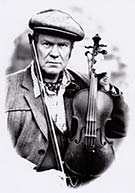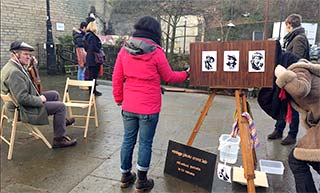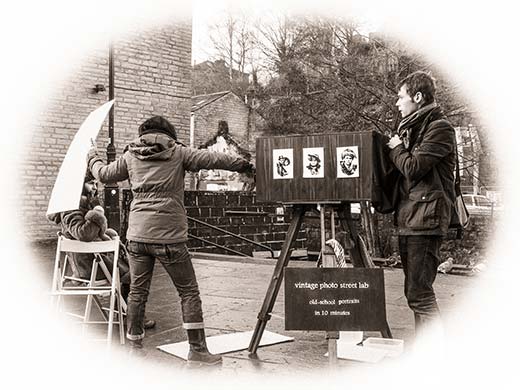Vintage photo street lab in Hebden Bridge
Friday, 9 January 2015
After the HebWeb snapped them in action by the river (below right) on Bridge Gate, this unusual Minutero photography group has sent us some info and photos.


They are practicing a type of photography they first came across many years ago in Madrid. They claim that the fully handmade, traditional process has a huge teaching value as it allows the public of the digital era to witness the birth of a photo from the beginning until the end.
In November 2013, they were able to arrange for a short, but intense, apprenticeship with Pascual Miralles in Spain, and became familiar with the basics of the technique.

Having built their first camera, they are now testing the material and fine-tuning of the results.
The process is a two-step (negative-positive) technique, probably closest to Calotype or Talbotype, an early photographic process introduced in 1841 by William Henry Fox Talbot, using paper coated with silver iodide.
The box of the camera is a fully equipped black and white laboratory - with the small "disadvantage" of having to handle everything in complete darkness, without that nice red bulb of a dark room.
It might sound banal, but another challenge is the weather itself as it alters the behavior of the chemicals and of course it's quite a task inserting the photographic paper in the proper place when hardly anything can be felt because of frozen fingertips!
They use hats and scarves in order to evoke the atmosphere of the era of 1920 to1950.
They are:
András: professional restorer and photographer;
Réka: former language teacher, dental laboratory technician, currently working as a barmaid in a local pub in Hebden Bridge;
Rita: freelance translator, photographer, who has worked as a "minutera" in Madrid with Pascual Miralles for 8 years.
In the future, they would love to take part in different events in the area, markets, art and crafts festivals, weddings, private parties etc. although traditionally the most natural site for this photography has always been the street itself.

The "minutera" photography ("photos in a minute") is a Spanish response to the ambulant photography, a genre that dates back to 1880-1890, the glory days of art. A field entirely forgotten by scholars, there's practically no reliable information available on the evolution and history of this type of photography. Nobody knows who was the first minutero, but by around 1900 there was already a fully functional "minutera" camera operated in Murcia, Spain.
The biggest "innovation" of the process consisted in placing the laboratory inside the box and speeding up the process in order to obtain a black and white photo while the costumer waits. They usually worked with a camera built by themselves utilizing all types of recycled material, and used curious paraphernalia like small wooden horses, airplane mock-ups, etc.
The Minuteros often travelled long distances on the back of a donkey with their equipment to set up their business during the festive days of a village or at a market. Taking photos at an affordable price they have an enormous merit as as the sole documenters of times, places and social classes that had rarely been in the focus of attention of professional photographers.
While ambulant photographers in Europe disappeared relatively early, on the streets of some Spanish towns it was quite common to stumble upon minuteros even in the middle of the 1970s. (There are still a few old photographers from this generation still active in Spain like don Roman Alas in Segovia, or Mariano in Santander.)
The genre would have probably become extinct by now if not rediscovered by a new generation of photographers, the most remarkable of whom is Pascual Miralles Alberola (1958), a photographer from Alicante, Spain. Practising for more than 14 years, Miralles developed a camera that reproduces 3 different formats (the biggest of which is 18x24 cm), and a timeless style that is more appealing to the aesthetic desires of the clients of our century.

